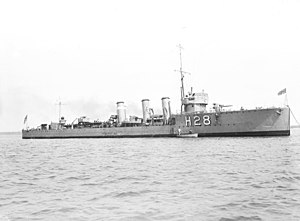
| |
| History | |
|---|---|
| Name | Nonsuch |
| Ordered | November 1914 |
| Builder | Palmers, Jarrow |
| Laid down | 17 November 1914 |
| Launched | 7 December 1915 |
| Completed | February 1916 |
| Out of service | 9 May 1921 |
| Fate | Sold to be broken up |
| General characteristics | |
| Class and type | Admiralty M-class destroyer |
| Displacement | 1,026 long tons (1,042 t) (normal) |
| Length | |
| Beam | 26 ft 8 in (8.1 m) |
| Draught | 8 ft 11 in (2.7 m) |
| Installed power | 3 Yarrow boilers, 26,030 shp (19,410 kW) |
| Propulsion | Parsons geared steam turbines, 3 shafts |
| Speed | 34 knots (63 km/h; 39 mph) |
| Range | 2,530 nmi (4,690 km; 2,910 mi) at 15 kn (28 km/h; 17 mph) |
| Complement | 80 |
| Armament |
|
HMS Nonsuch was a Repeat Admiralty M-class destroyer that served in the Royal Navy during the First World War. The M class was an improvement on those of the preceding L class, capable of higher speed. Originally laid down as HMS Narcissus but renamed before being launched in 1915, Nonsuch joined the Twelfth Destroyer Flotilla of the Grand Fleet. During the Battle of Jutland in 1916, after being attacked by the light cruisers of the German High Seas Fleet, the warship rescued the damaged destroyer Acasta. The vessel formed part of the screen for the dreadnought battleships of the First Battle Squadron during the Second Battle of Heligoland Bight in 1917. In both actions, the destroyer reported no hits. After the Armistice that ended the war, Nonsuch was initially put in reserve and then sold in 1921 to be broken up.